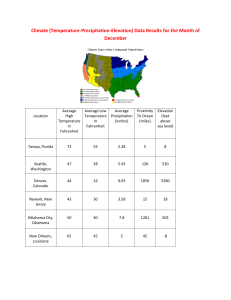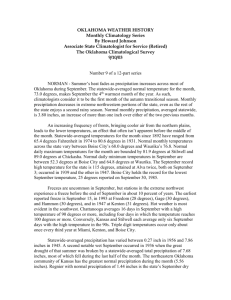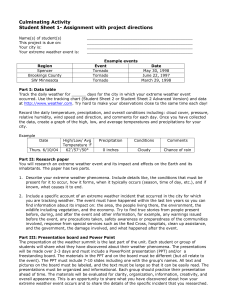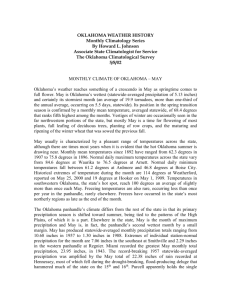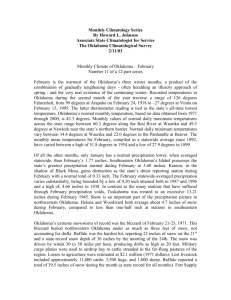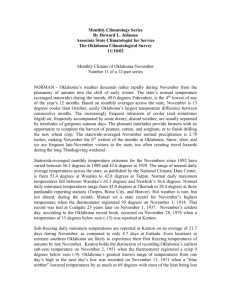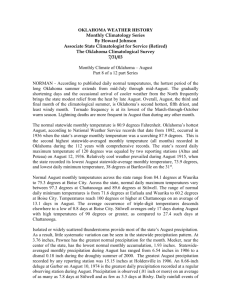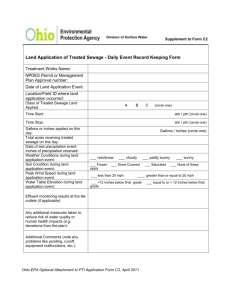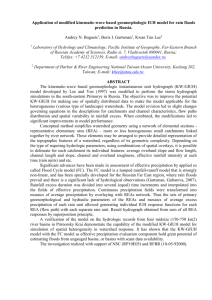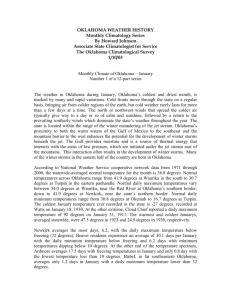Word - CIG
advertisement
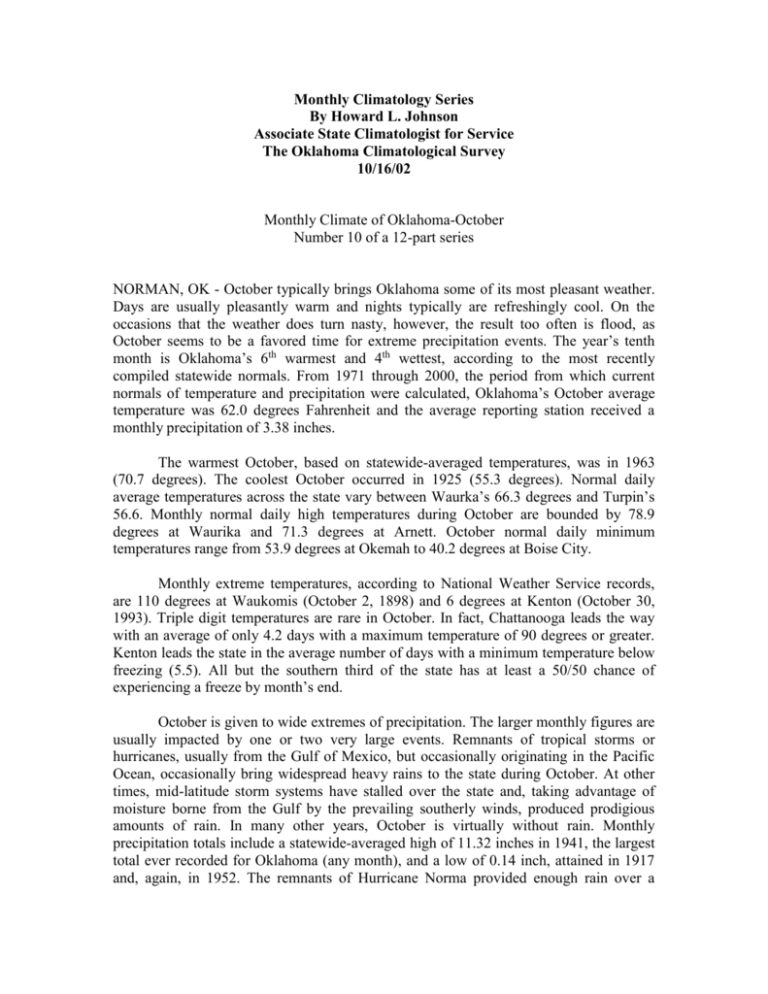
Monthly Climatology Series By Howard L. Johnson Associate State Climatologist for Service The Oklahoma Climatological Survey 10/16/02 Monthly Climate of Oklahoma-October Number 10 of a 12-part series NORMAN, OK - October typically brings Oklahoma some of its most pleasant weather. Days are usually pleasantly warm and nights typically are refreshingly cool. On the occasions that the weather does turn nasty, however, the result too often is flood, as October seems to be a favored time for extreme precipitation events. The year’s tenth month is Oklahoma’s 6th warmest and 4th wettest, according to the most recently compiled statewide normals. From 1971 through 2000, the period from which current normals of temperature and precipitation were calculated, Oklahoma’s October average temperature was 62.0 degrees Fahrenheit and the average reporting station received a monthly precipitation of 3.38 inches. The warmest October, based on statewide-averaged temperatures, was in 1963 (70.7 degrees). The coolest October occurred in 1925 (55.3 degrees). Normal daily average temperatures across the state vary between Waurka’s 66.3 degrees and Turpin’s 56.6. Monthly normal daily high temperatures during October are bounded by 78.9 degrees at Waurika and 71.3 degrees at Arnett. October normal daily minimum temperatures range from 53.9 degrees at Okemah to 40.2 degrees at Boise City. Monthly extreme temperatures, according to National Weather Service records, are 110 degrees at Waukomis (October 2, 1898) and 6 degrees at Kenton (October 30, 1993). Triple digit temperatures are rare in October. In fact, Chattanooga leads the way with an average of only 4.2 days with a maximum temperature of 90 degrees or greater. Kenton leads the state in the average number of days with a minimum temperature below freezing (5.5). All but the southern third of the state has at least a 50/50 chance of experiencing a freeze by month’s end. October is given to wide extremes of precipitation. The larger monthly figures are usually impacted by one or two very large events. Remnants of tropical storms or hurricanes, usually from the Gulf of Mexico, but occasionally originating in the Pacific Ocean, occasionally bring widespread heavy rains to the state during October. At other times, mid-latitude storm systems have stalled over the state and, taking advantage of moisture borne from the Gulf by the prevailing southerly winds, produced prodigious amounts of rain. In many other years, October is virtually without rain. Monthly precipitation totals include a statewide-averaged high of 11.32 inches in 1941, the largest total ever recorded for Oklahoma (any month), and a low of 0.14 inch, attained in 1917 and, again, in 1952. The remnants of Hurricane Norma provided enough rain over a three-day period in October 1981 to give Madill the greatest monthly precipitation total (25.80 inches) ever recorded at a recognized reporting station in Oklahoma (all months). A thoroughly extra-tropical thunderstorm system inundated Enid with 15.68 inches of rain in about 12 hours (12 inches in just 3 hours) on October 10, 1973. That total, reported the following morning, is the state’s greatest 24-hour precipitation in any month, as measured at an official reporting station. The normal precipitation pattern across Oklahoma in October returns to its familiar configuration with eastern stations receiving substantially more rainfall than those in the west. Normal monthly precipitation across the state during October ranges from 6.22 inches at Smithville to 0.99 inches at Kenton. Measurable precipitation is observed on an average of 9.1 days in October at Stilwell, but only on 2.9 days on the dry side of the state at Regnier. Snowfall is not common during October, but Regnier, Kenton, and Boise City each average receiving about one inch of snow during the month. Those averages were inflated by a freak snowstorm on October 25 and 26, 1997 that dropped 15 inches of snow on Kenton. As many as 15,000 head of cattle across the panhandle died during that snowstorm. When October weather is bad, it usually consists of heavy rain, often resulting in floods. The October 1941 statewide-averaged precipitation record was aided greatly by the 22.66 inches of rain recorded at Pensacola that month. Five other stations in eastern and central Oklahoma reported rainfall of 20 inches or more to contribute to the record. Multiple floods were reported on many of the state’s rivers during that particularly cloudy and rainy month. Madill, Tishomingo, Kingston, and Marietta all topped the Pensacola monthly total of 40 years prior when Norma’s remnants drifted into south central Oklahoma on October 10, 1981. That month’s officially reported precipitation totals (most of the rain fell from the 10th through the 12th) ranged from the previously mentioned 25.80 inches at Madill to 24 inches at Marietta. Unofficial reports indicated that as much as 16 inches of rain fell in 16 hours in northwestern Marshall County. The floods caused by the record-setting Enid storm of 1973 killed nine people. Associated flooding was felt from the Kansas border in Kay, Grant and Alfalfa counties south to Dover in Kingfisher County where Turkey Creek inundated 125 of the town’s 150 residences with floodwaters 4 to 6 feet deep. A particularly unusual flood event occurred when an 18-to-20 foot-high wall of water devastated the Canadian River flood plain the first four days of October in 1904. Rains in eastern New Mexico provided the water for this dramatic flood that occurred under clear Oklahoma skies. Heavy rains all across the eastern two-thirds of the state culminated in extensive flooding along the Glover and Little rivers in southeastern Oklahoma beginning on October 30, 1972. A more famous October flood, and surely one that had an enormous social impact, was the October 13-16, 1923 North Canadian River flood that caused great devastation in Oklahoma City. The floodwaters, produced by copious rains in the river’s northwestern Oklahoma watershed, breached the earthen embankments of the Lake Overholser Dam and caused $15 million (1923 prices) worth of damage in the capitol city. Remnants of Hurricane Tico (a Pacific Ocean storm) in 1983 and Hurricane Paine in 1986 also produced notable floods. There have been other floods of similar magnitude during other Octobers, ultimately impacting all of the rivers and streams in the state and more than a few low spots removed from perennial watercourses. Severe thunderstorms, apart from the floods, historically have been little more than footnotes in October for most of the state’s history. However, recent occurrences have altered that notion somewhat. Reasonably comprehensive and well-documented tornado records in the state date from 1950. During those 52 years, 123 October tornadoes have been identified in Oklahoma, an average of 2.3 per year. There were no October tornadoes reported during 21 of those years. However, 25 tornadoes were reported in the state on October 4, 1998 and 19 more were reported on October 9, 2001. Those two days account for over one-third of the tornadoes reported (and confirmed) within the state in October during that 52-year period. The state’s monthly total of 27 tornadoes during October 1998 represents the most tornadoes ever reported within any state during an October. No lives were lost during the 1998 and 2001 outbreaks, despite the fact that Cordell took a direct hit on October 9, 2001. Nine people were injured, 477 homes and 40 businesses were badly damaged in the Washita County community. Economic losses from the storm exceeded $100 million. The deadliest October tornado in the state, according to the best available record, struck Shawnee on October 5, 1970, killing four people and damaging 748 buildings. There have been a few significant October hailstorms. Probably the most devastating of those occurred on October 5, 1951, when crops were destroyed along a 5mile wide, 70-mile long swath across Harmon, Greer, and Kiowa counties. Accompanied by very strong winds, the hail destroyed 18,000 acres of cotton and sorghum. Total losses included $175,000 in crops and $70,000 to buildings and automobiles (at 1951 prices). Another extreme weather event occurred during the drought year of 1952. October was the last and driest month of that year’s six-month drought as only five reporting stations in the state (all in Sequoyah and LeFlore counties) recorded as much as an inch of rain. Spiro’s 1.66 inches was the largest monthly precipitation in the state during that extremely dry October. Media Contact: For Additional Information: Cerry Leffler Oklahoma Climatological Survey 100 E. Boyd, Suite 1210 Norman, OK 73019-1012 405-325-2541 405-325-2550 (fax) cerry@ou.edu Howard Johnson Associate State Climatologist for Service 100 E. Boyd, Suite 1210 Norman, OK 73019-1012 405-325-2541 405-325-2550 (fax) hjohnson@ou.edu
